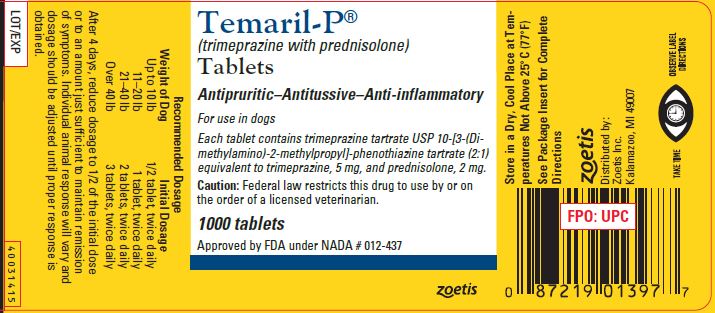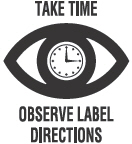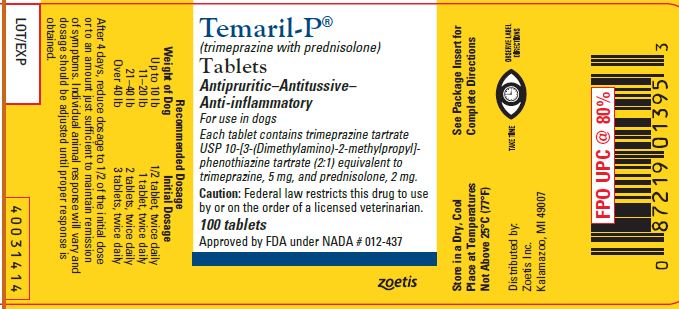Label: TEMARIL-P- trimeprazine tartrate and prednisolone tablet
- NDC Code(s): 54771-8550-1, 54771-8550-2
- Packager: Zoetis Inc.
- Category: PRESCRIPTION ANIMAL DRUG LABEL
- DEA Schedule: None
- Marketing Status: New Animal Drug Application
Drug Label Information
Updated January 12, 2023
If you are a consumer or patient please visit this version.
- Download DRUG LABEL INFO: PDF XML
- Official Label (Printer Friendly)
- SPL UNCLASSIFIED SECTION
- CAUTION
- DESCRIPTION
- Action
-
INDICATIONS AND USAGE
1. Antipruritic
Temaril-P is recommended for the relief of itching regardless of cause. Its usefulness has been demonstrated for the relief of itching and the reduction of inflammation commonly associated with most skin disorders of dogs such as the eczema caused by internal disorders, otitis, and dermatitis (allergic, parasitic, pustular, and nonspecific). It often relieves pruritus which does not respond to other therapy. With any pruritus treatment, the cause should be determined and corrected; otherwise, signs are likely to recur following discontinuance of therapy.
2. Antitussive
Temaril-P has been found to be effective therapy and adjunctive therapy in various cough conditions of dogs. Therefore, in addition to its antipruritic action, Temaril-P is recommended for the treatment of "kennel cough" or tracheobronchitis, bronchitis including all allergic bronchitis, and infections and coughs of nonspecific origin. (Coughs due to cardiac insufficiencies would not be expected to respond to Temaril-P therapy.) As with any antitussive treatment, the etiology of the cough should be determined and eliminated if possible. Otherwise, symptoms are likely to recur following discontinuance of therapy.
Note: Temaril-P may be administered to animals suffering from acute or chronic bacterial infections provided the infection is controlled by appropriate antibiotic or chemotherapeutic agents.
-
WARNING
Clinical and experimental data have demonstrated that corticosteroids administered orally or by injection to animals may induce the first stage of parturition if used during the last trimester of pregnancy and may precipitate premature parturition followed by dystocia, fetal death, retained placenta, and metritis. Additionally, corticosteroids administered to dogs, rabbits, and rodents during pregnancy have resulted in cleft palate in offspring. Corticosteroids administered to dogs during pregnancy have also resulted in other congenital anomalies, including deformed forelegs, phocomelia, and anasarca. If a vasoconstrictor is needed, norepinephrine should be used in lieu of epinephrine. Phenothiazine derivatives may reverse the usual elevating action of epinephrine causing a further lowering of blood pressure.
-
PRECAUTIONS AND SIDE EFFECTS
All the precautions applicable to cortisone and to phenothiazine derivatives apply also to Temaril-P. Possible side effects attributable to corticosteroids include sodium retention and potassium loss, negative nitrogen balance, suppressed adrenal cortical function, delayed wound healing, osteoporosis, elevated levels of SGPT and SAP, and vomiting and diarrhea (occasionally bloody). Cushings syndrome in dogs has been reported in association with prolonged or repeated steroid therapy. Possible increased susceptibility to bacterial invasion and/or the exacerbation of preexisting bacterial infection may occur in patients receiving corticosteroids. As noted above, however, this problem can be avoided by concomitant use of appropriate anti-infective agents. Possible side effects attributable to phenothiazine derivatives include sedation; protruding nictitating membrane; blood dyscrasias; intensification and prolongation of the action of analgesics, sedatives and general anesthetics; and potentiation of organophosphate toxicity and the activity of procaine hydrochloride.
It should be remembered that the premonitory signs of cortisone overdosage, such as sodium retention and edema, may not occur with prednisolone. Therefore, the veterinarians must be alert to detect less obvious side effects, such as blood dyscrasias, polydipsia, and polyuria.
The appearance and severity of side effects are dose related and are minimal at the recommended dosage level. If troublesome side effects are encountered, the dosage of Temaril-P should be reduced and discontinued unless the severity of the condition being treated makes its relief paramount.
Prolonged treatment with Temaril-P must be withdrawn gradually. Use of corticosteroids, depending on dose, duration, and specific steroid, may result in inhibition of endogenous steroid production following drug withdrawal. In patients presently receiving or recently withdrawn from systemic steroid treatments, therapy with a rapidly acting corticosteroid should be considered in unusually stressful situations.
-
DOSAGE AND ADMINISTRATION
The same dosage schedule may be followed for both antipruritic and antitussive therapy.
Weight of Dog Initial Dosage Up to 10 lb 1/2 tablet, twice daily 11–20 lb 1 tablet, twice daily 21–40 lb 2 tablets, twice daily Over 40 lb 3 tablets, twice daily After 4 days, reduce dosage to 1/2 of the initial dose or to an amount just sufficient to maintain remission of symptoms. Individual animal response will vary and dosage should be adjusted until proper response is obtained.
- STORAGE AND HANDLING
- HOW SUPPLIED
-
REFERENCES
1. Knowles JO, Knowles RP: Preliminary reports on an effective antipruritic agent. Vet Med 55(8):67–68, 1960.
2. Candlin FT: An agent to aid in control of pruritus. Vet Med 56(5):207–208, 1961.
3. Yoxall AT, Hird JRF: Pharmacological Basis of Small Animal Medicine. Blackwell Scientific Publications, London, pp. 99–102, 1979.
4. Booth N, McDonald LE: Veterinary Pharmacology and Therapeutics, 5th ed. Iowa State University Press, Ames, pp. 564–570, 1982.
5. Davis L: Handbook of Small Animal Therapeutics.Churchill Livingstone, New York, pp. 140–142; 459–461; 468–469, 1985.
6. Scott D: Systemic glucocorticoid therapy. Current Veterinary Therapy, Kirk WV Saunders, ed., Philadelphia, pp. 988–994, 1980.
7. Lecture: “Rational Steroid Therapy” Duncan C. Ferguson, VMD, PhD, Department of Pharmacology, Cornell University.
8. Kemppianen RJ, Lorenz MD, Thompson FN: Adrenocortical suppression in the dog given a single intramuscular dose of prednisolone or triamcinolone acetonide. Am J Vet Res 42(2):204–206, 1982.
9. Rogers WA, Ruebner BH: A retrospective study of probable glucocorticoid induced hepatopathy in dogs. JAVMA 1977;170(6): 603-605.
- SPL UNCLASSIFIED SECTION
- PRINCIPAL DISPLAY PANEL - 100 Tablet Bottle Label
- PRINCIPAL DISPLAY PANEL - 1000 Tablet Bottle Label
-
INGREDIENTS AND APPEARANCE
TEMARIL-P
trimeprazine tartrate and prednisolone tabletProduct Information Product Type PRESCRIPTION ANIMAL DRUG Item Code (Source) NDC:54771-8550 Route of Administration ORAL Active Ingredient/Active Moiety Ingredient Name Basis of Strength Strength TRIMEPRAZINE TARTRATE (UNII: 362NW1LD6Z) (TRIMEPRAZINE - UNII:76H78MJJ52) TRIMEPRAZINE 5 mg PREDNISOLONE (UNII: 9PHQ9Y1OLM) (PREDNISOLONE - UNII:9PHQ9Y1OLM) PREDNISOLONE 2 mg Product Characteristics Color gray Score 2 pieces Shape ROUND Size 9mm Flavor Imprint Code T100 Contains Packaging # Item Code Package Description Marketing Start Date Marketing End Date 1 NDC:54771-8550-1 100 in 1 BOTTLE 2 NDC:54771-8550-2 1000 in 1 BOTTLE Marketing Information Marketing Category Application Number or Monograph Citation Marketing Start Date Marketing End Date NADA NADA012437 09/30/1960 Labeler - Zoetis Inc. (828851555)





